BLOG ARTICLE
Create a podcast landing page and attract new listeners (with actionable tips and examples)
Last updated: 12/16/2025
Last updated: 12/16/2025
As podcast creators, we all share the common objective of increasing downloads and generating monthly revenue from our podcast audience.
However, achieving this goal doesn't happen by simply publishing your podcast on platforms like Spotify or Apple Podcasts and waiting for things to unfold on their own. Instead, we need to actively engage with our audience, going the extra mile to connect with them and promote our content.
And that's why having a podcast landing page is a must. A Podcast landing page is key to establishing a connection with listeners and promoting a podcast.
In this guide, we're diving into the art of creating and optimizing a landing page for a podcast. Whether you're a seasoned podcaster looking to enhance your online presence or a newbie gearing up for launch, we've got you covered.
Let’s dive in 👇
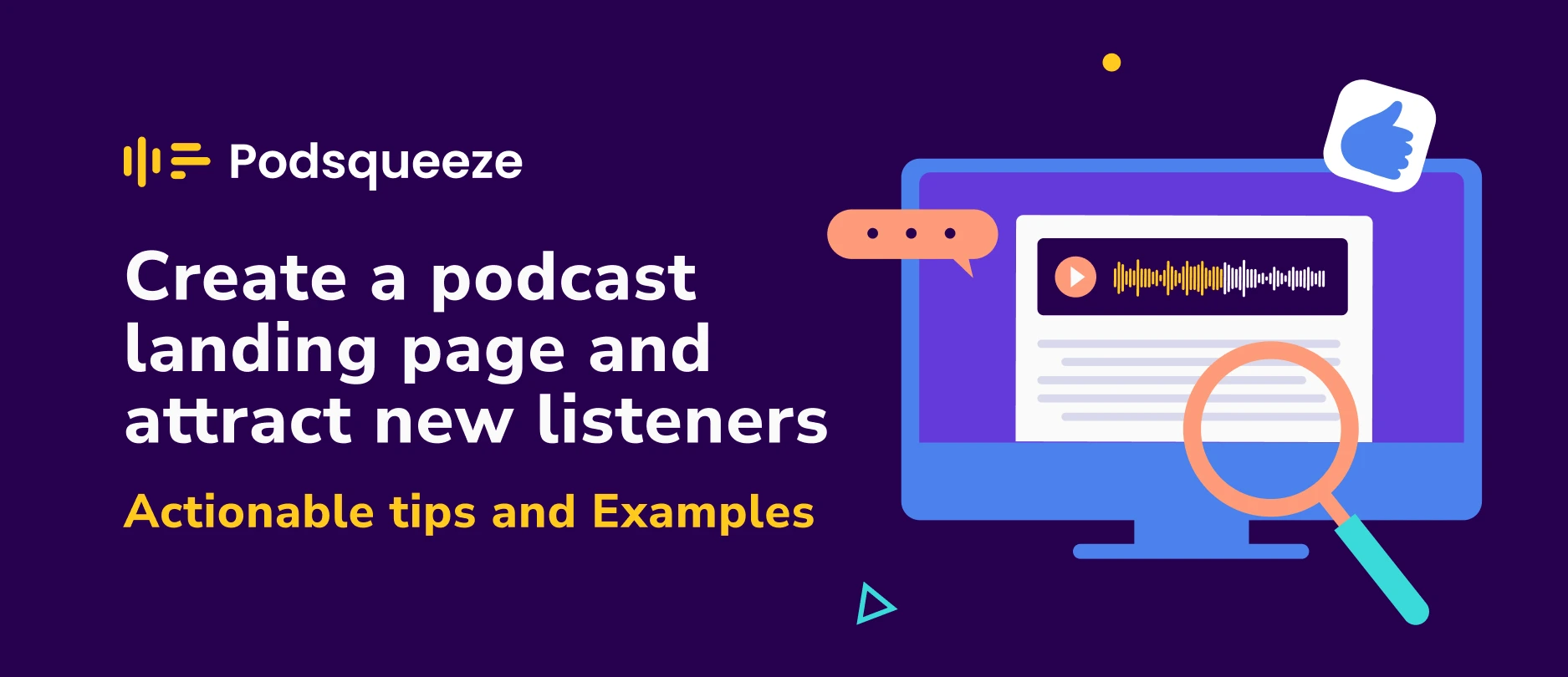
What’s a Podcast Landing Page
A podcast landing page is a dedicated webpage that you create to promote your podcast. It acts as a hub for listeners who are interested to learn more about your podcasta and access your episodes and additional content.
What are the benefits of a Podcast Landing Page
- Improves your SEO: A well-crafted landing page with targeted keywords enhances your podcast's discoverability on search engines, drawing in new listeners.
- Establish your authority: By adding additional information about the host and their background and by showcasing social proof, a landing page helps establish you as an authority in your topic amongst new visitors.
- Convert your subscribers into customers: A Podcast landing page lets you convert your podcast’s passive listeners into customers by motivating them to engage with your products through a call-to-action.
Despite all of these 3 major benefits...
The main purpose of a Podcast Landing Page is Conversions.
A podcast landing page is meant to convert your audience into subscribers and customers.
Anyway, enough with the theory. Let’s take a look at a few real-life examples of podcast landing pages and how they look like.
Podcast Landing Page Examples
- Perpetual Traffic Podcast (landing page to grow newsletter subscribers)
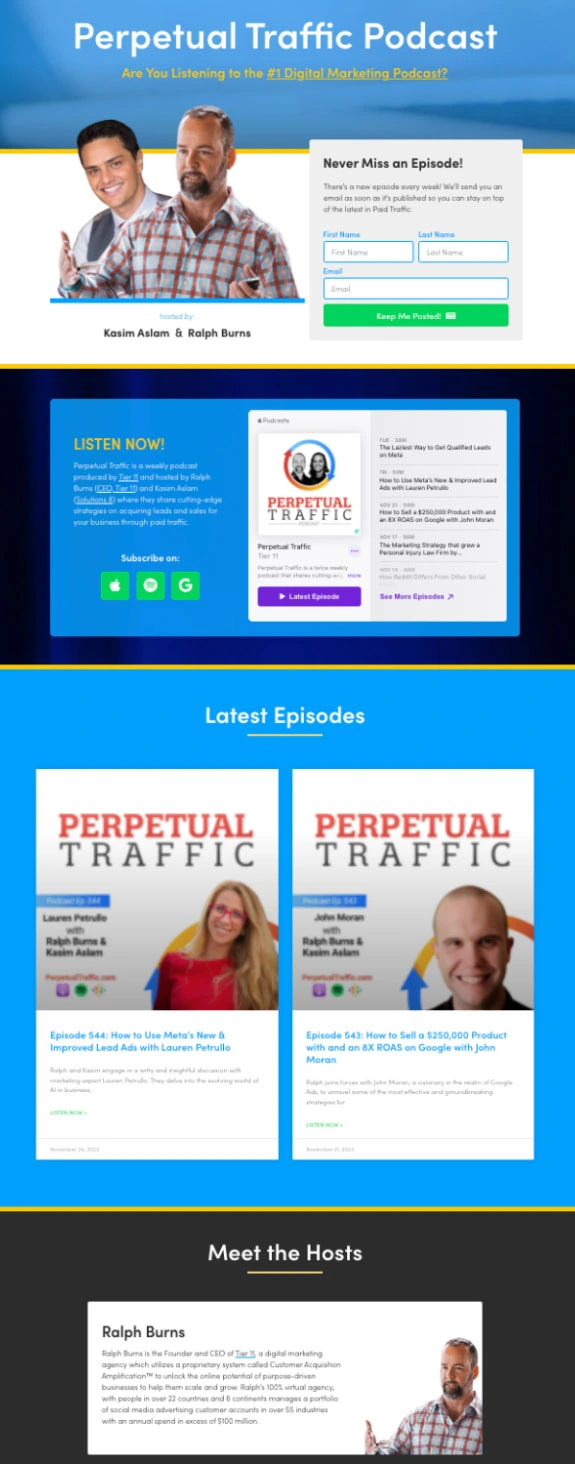
This podcast landing page has been optimized to grow the email subscribers for the podcast. So it starts with a newsletter sign up form right at the top of the landing page with images of the podcast hosts to add authority. And it is followed by links to the latest episodes of the podcast and subscribe buttons for listeners to catch up the podcast on various podcasting platforms.
- Radio Labs Podcast (landing page that nudges visitors to join membership)
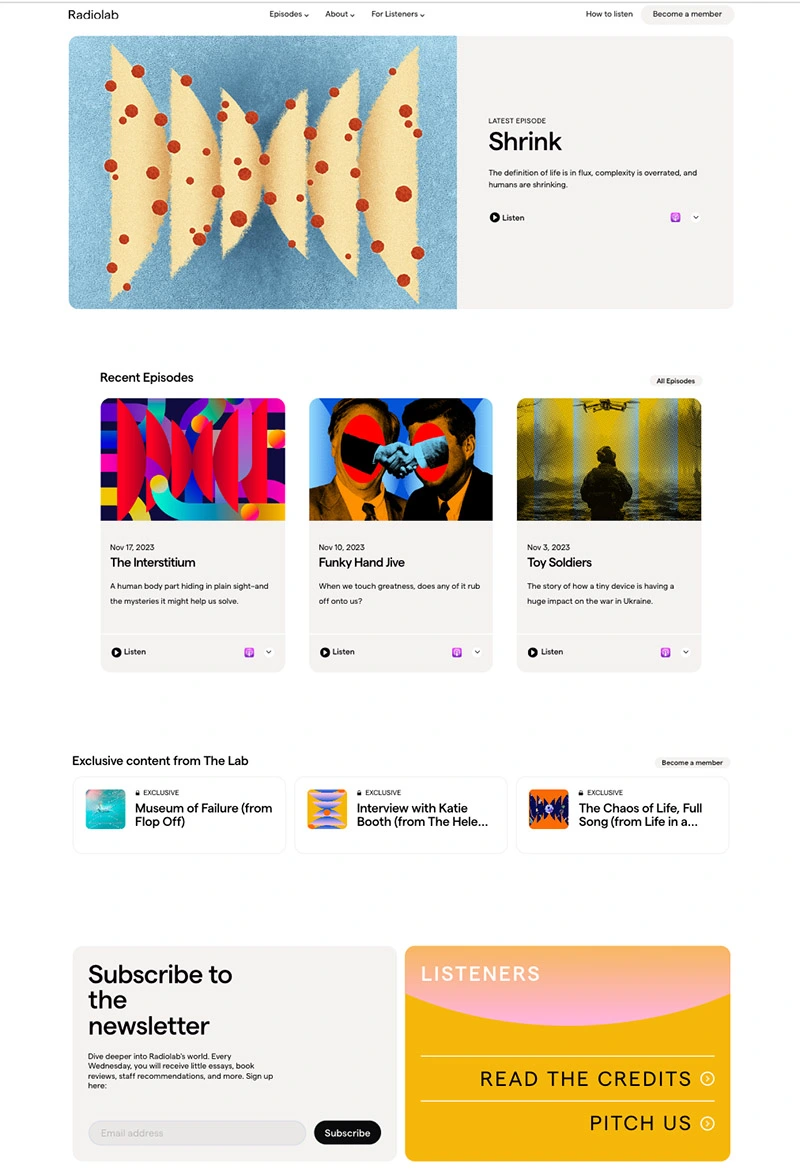
Unlike the previous example, this landing page has been designed to showcase its episodes on the forefront. It starts with a shoutout to the show's latest episode, followed by a recent episodes section for visitors to explore and a CTA that nudges users to join a paid membership to get access to exclusive content.
- Hurdle Podcast ( landing page that Upsells paid products/services)
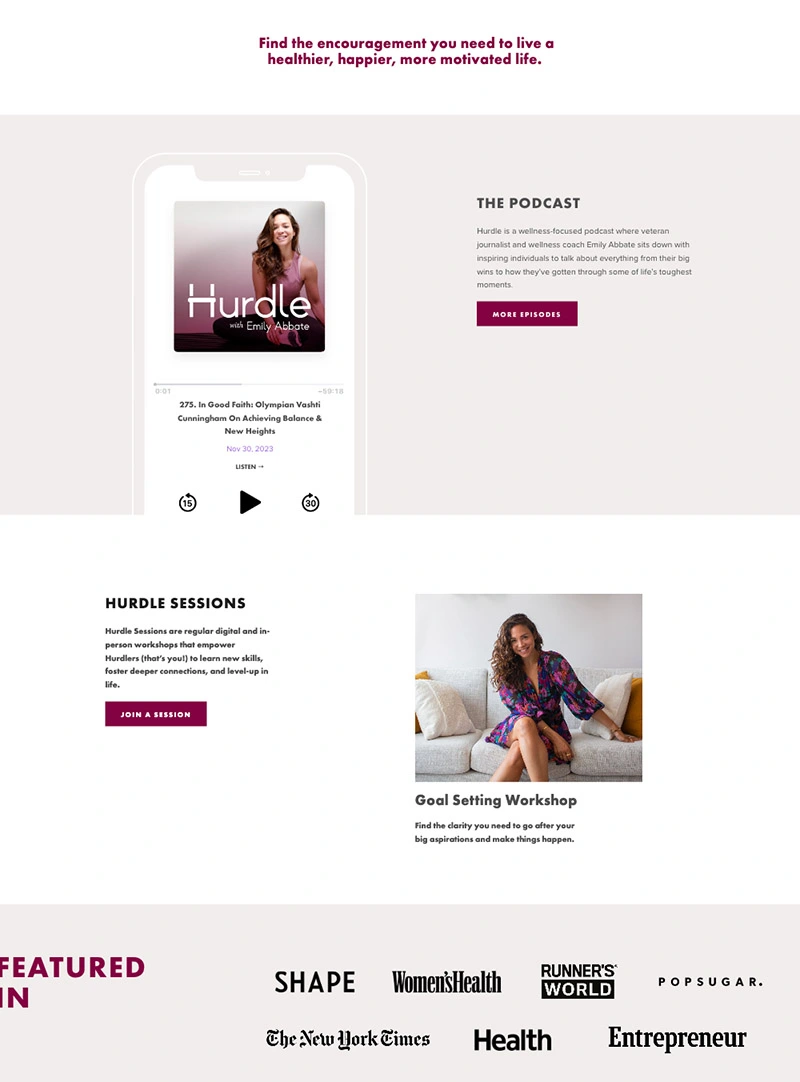
The landing page of the hurdle podcast starts with a big-promise in its headline enticing visitors to listen to the podcast. The landing page has a CTA to upsell the paid sessions and workshops they offer followed by a “Featured In” section right below that adds social proof and builds trust for new visitors.
What should you add in Your Podcast Landing Page
Now that you’ve seen examples of podcast landing pages and how they look, let’s break down all the elements you need to add to your own podcast landing page and create a template/blueprint for you to get started.
Headline / Title
The podcast headline is the initial point of contact for visitors on the landing page. It lets you grab their attention and make them scroll down to learn further about your podcast.
You can make your landing page title intriguing for visitors by:
- Addressing the target audience
Ex: Marketing hacks for ecommerce business owners
- Promising an end goal or result
Ex: 2X your sales by joining this cold email podcast
- Adding authority by adding your name (if you’re already popular in your niche)
Ex: Storytelling lessons with {Your name}
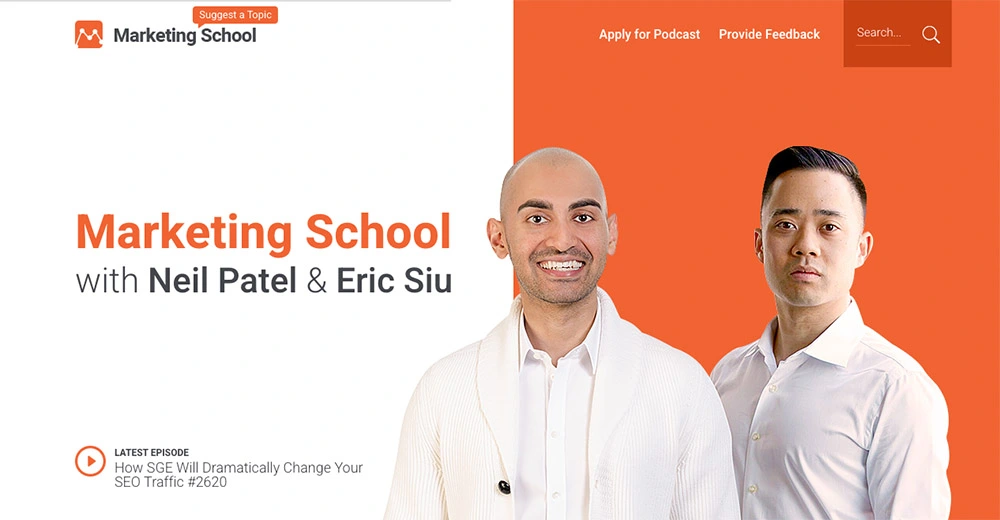
Podcast description
The podcast headline is usually followed by the description of the show.
The description section is an overview of a podcast that gives the listeners a quick snapshot about what your podcast is about that captures their attention and engages them further.
How to optimize your show's description on your landing page
- Keyword Optimization: Use a keyword research tool to identify relevant keywords that align with your podcast. Include these keywords into your page's description, title and URL if possible. For newly established pages, target long-tail keywords (lengthier and more specific phrases) with lower competition but still maintaining a relevant search volume.
- Share key takeaways from your podcast: Create a section that tells the key takeaways that listeners can get from listening to your podcast.
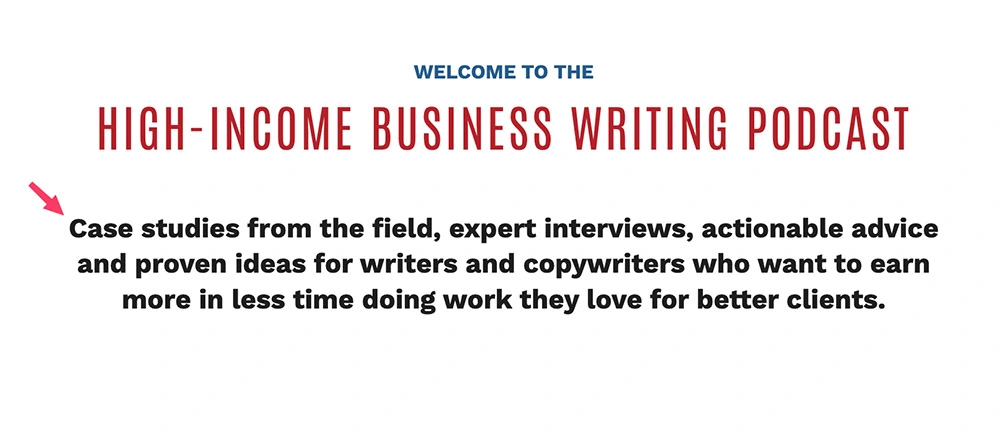
Links to your most popular episodes or a series
People won’t subscribe to your podcast right after they come to your landing page, unless they know what they’re signing up for.
So give your page visitors a taste of what to expect in your podcast by adding links to your most popular episodes. You can also recommend a series of episodes on a particular topic (for ex: 10 french recipes to try)
This will keep visitors engaged with your podcast when they discover you for the first time and increase your chances of converting them to loyal subscribers.
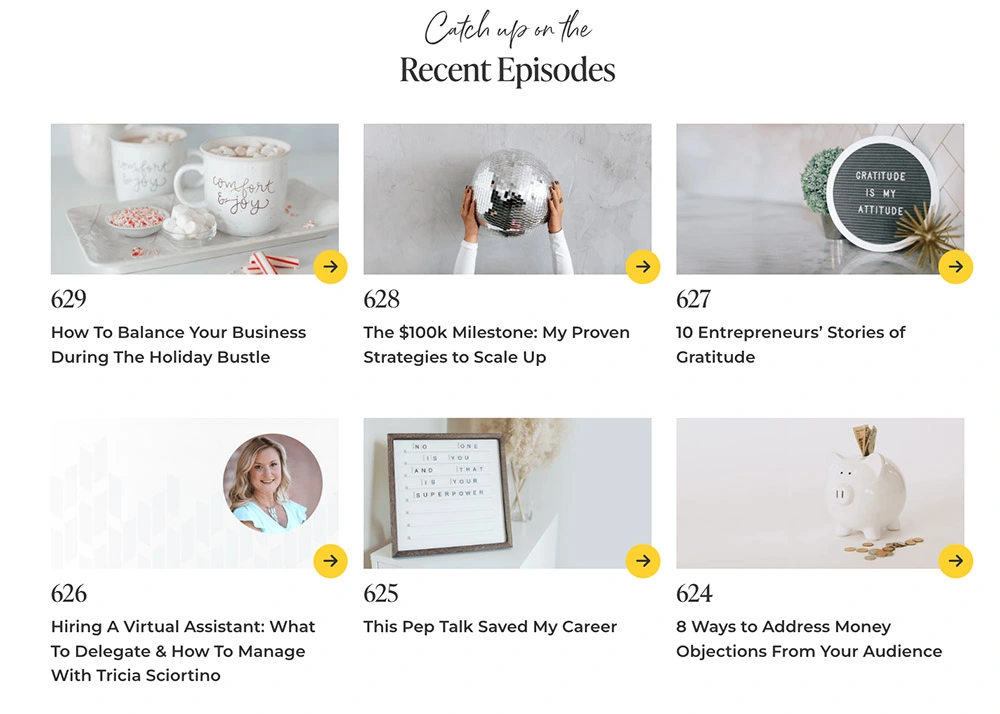
Social Proof
Incorporating social proof on your landing page signals to your visitors that your podcast has garnered approval from others who've already listened. Beyond that, it introduces a sense of FOMO (fear of missing out), suggesting they might miss out on something exceptional if they don't dive into your podcast immediately.
So social proof is a must-have section to convert visitors who passively land on your page into active listeners and subscribers.
Some of the elements you can add to your social proof section include:
- Prominent guests you’ve had on your show
- The number of downloads you’ve got
- Reviews shared by your listeners
Here’s an example:

Add a Call-to-Action
The call-to-action is the most important section of your landing page. This is where you guide your visitors to become subscribers and paying customers of your podcast.
There are different types of call-to-action you can add on your landing page:
- Offer a lead magnet or giveaway - Give away a free resource like a guide or an helpful ebook and encourage them to join your email list where you can upsell your paid products in the future.
- Including a link to purchase your product - Add links to purchase your products directly in your landing page. This works best if you’re selling merch or low-ticket products that are less than $100.
- Adding a Donate button to your landing page with perks - If you don’t have anything to sell at the moment, you can still add a "Buy me a coffee" button on your landing page and accept donations from your audience in exchange for exclusive perks, such as access to a members-only community.
Here’s an example of a lead-magnet call to action:
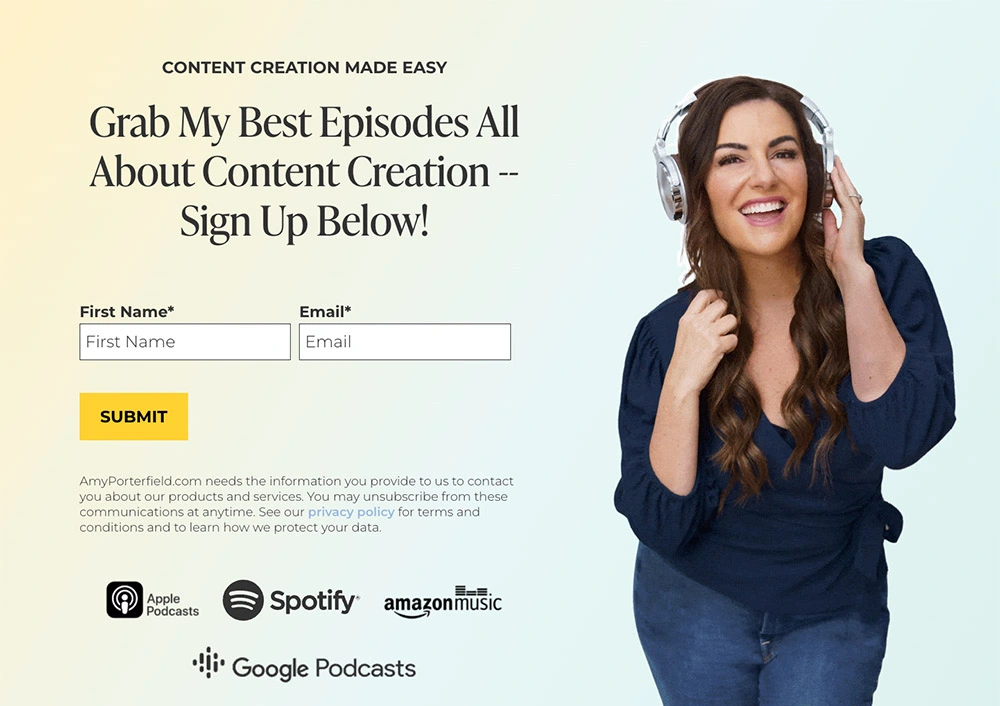
Links to popular podcast platforms
Every visitor has their own choice of platform which they prefer to listen to podcasts. So make sure you add links to all the podcasting platforms like Apple Podcasts, Audible or Spotify where they can find your podcast.
This makes it easier for your audience to subscribe to and listen to your podcast on the app they’re most comfortable with when a new episode is out.
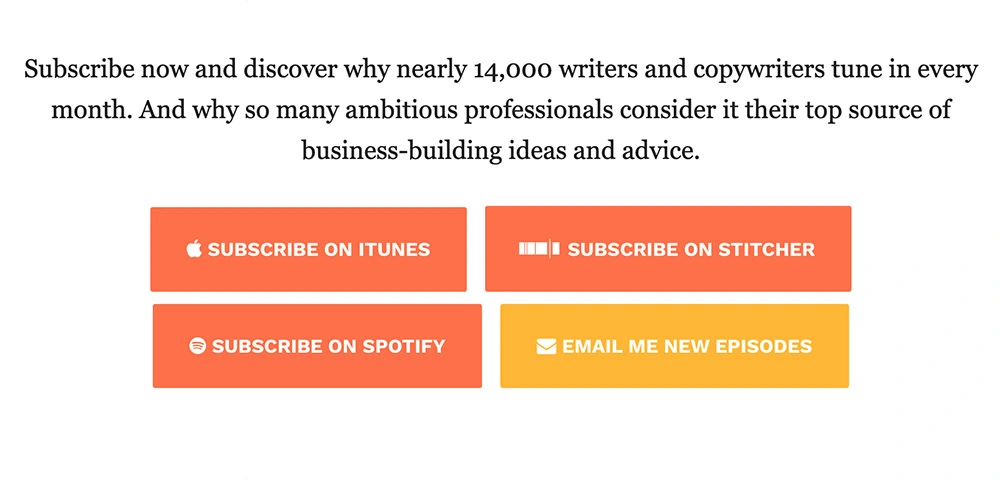
Implement Social Sharing
The more your podcast gets shared on social media, the higher the downloads you get for your podcast. So it's important to add social sharing buttons into your podcast landing page.
Social sharing buttons can significantly increase your reach and engagement on all platforms when your audience shares your landing page on their profile, be it on twitter, Instagram or tiktok.
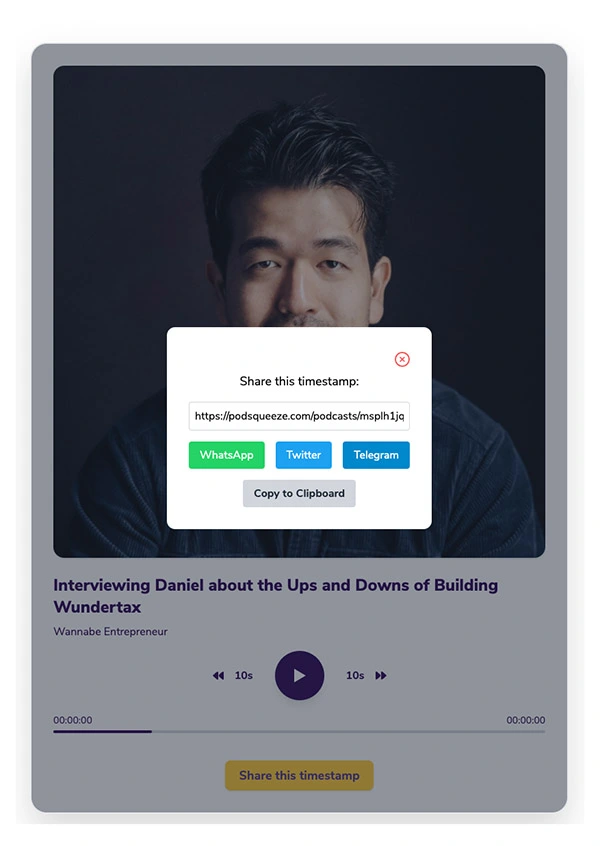
How to promote and share your podcast landing page
After crafting your podcast landing page, there's one more important step – promoting and sharing it.
While SEO contributes to organic traffic, actively sharing and promoting your landing page is crucial for maximizing its reach and attracting visitors.
Where can you share your podcast landing page
- Podcasting platforms - You can add a link to your landing page in the "about" section of podcasting directories like spotify and within your episode descriptions. Give a shout out to your landing page on all your episodes and ask listeners to check it out for more helpful resources or to sign up to your newsletter.

- Link in Bio - Add your landing page to the bio of your social media profiles on instagram, twitter, titkotk & encourage your profile visitors to check out your landing page.
Tip: You can get more clicks to your podcast landing page by promising a free resource or lead magnet which visitors can get on the page.

- Run paid ads - Run ads to your landing page on social media where your target audience hangs out the most (twitter/ Instagram or even reddit). This will help you grow the following of your podcast much faster.
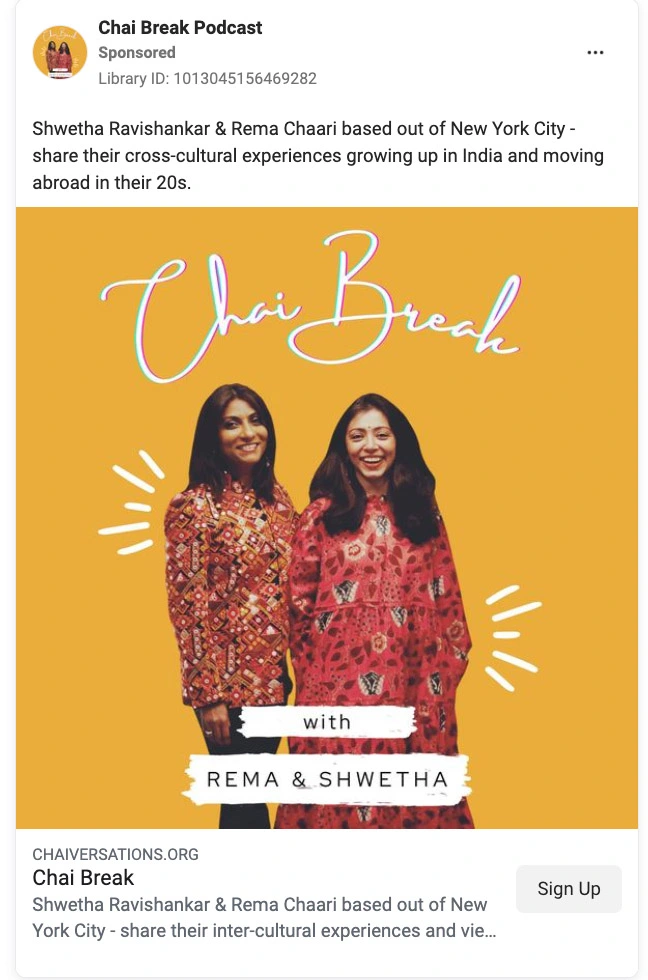
Make use of these methods to promote your podcast landing page across all channels and get consistent traffic to the landing page page.
How do you create a Podcast landing page?
Now that you know what are the elements of a podcast landing page and some ideas on how to promote it, let’s explore some website builder tools that let you design a landing page:
- Webflow: Webflow is a visual website builder that lets you build response websites and landing pages visually and comes with in-built hosting. It starts from $19/mo
- WordPress: There are two versions of WordPress that give you different levels of control. WordPress.COM is like a website builder – it handles everything, from hosting your site to security. It's similar to other website builders on this list, offering a free plan and paid options starting at $4 per month. On the flip side, WordPress.ORG is free software you install on external hosting. It's more advanced and a big hit with web designers since it lets you build professional websites without needing to code.
- SquareSpace: SquareSpace is another tool that lets you build a landing page for your podcast through a customizable website builder. The pricing starts from $16/mo.
- Wix: Wix is a popular user-friendly platform for creating websites without advanced technical skills. It offers templates, drag-and-drop tools, and hosting services. Pricing starts from $10/mo.
- CoHost: CoHost is a podcast analytics platform that also provides automatic, SEO-optimized, podcast websites. With no external website builder required, users are given an automatic podcast website that they can customize and manage.
Now, If you want to create simpler podcast episode landing pages that do not require any learning curve or design knowledge, you should try using Podsqueeze Landing Pages.
Podsqueeze is an AI tool that can automatically generate eye-catching landing pages for your podcast episodes at the click of a button, featuring automatic show notes and a player with clickable chapters. Not only that, podsqueeze generates all the content needed to promote your podcast episodes including blog and social media posts, newsletters, clips, audiograms, and much more.
With the Podsqueeze app, you can save a lot of time each week on putting out and sharing your podcast and focus more on creating an awesome show.
FAQs on creating a podcast landing page and attracting new listeners
-
What should I include on my podcast landing page?
Your landing page should have a clear and compelling podcast description of your podcast, including your podcast title, theme, and target audience. There should also be high-quality graphics or images related to your podcast, links to subscribe on various platforms, episodes or podcast highlights, testimonials or reviews, and a call-to-action to encourage visitors to subscribe or listen.
-
What are some strategies for attracting new listeners to my podcast?
You can start by using social media platforms as podcast promotions. Platforms like Instagram, Twitter, and LinkedIn, coupled with using relevant hashtags and engaging with your audience will increase your odds of getting new listeners. Additionally, collaborate with other podcasters or influencers in your niche for cross-promotion opportunities. You can also try running ads on platforms like Facebook or Google to reach a broader audience. You can also guest on other podcasts or participate in relevant online communities to increase visibility.
-
How can I optimize my landing page for SEO?
Optimizing your landing page for search engines requires ensuring your title and meta description are descriptive and include relevant keywords. Use headings and subheadings to structure your content, include alt text for images, and make sure your page loads quickly. Additionally, consider creating short blog posts or other content related to your podcast niche to drive traffic to your landing page.
Repurpose your podcast content with AI